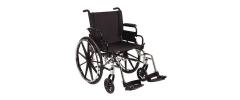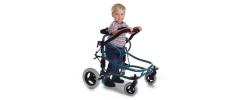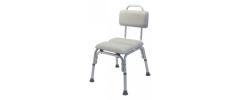The Ultimate Guide to Choosing and Maintaining Your Wheelchair Caster Wheels
Shop Wheelchair Caster Wheels
Your wheelchair's caster wheels might be small, but they have a huge impact on your daily mobility. As the front wheels of your chair, they determine how easily you can steer, turn, and navigate different surfaces. Choosing the wrong casters can lead to frustration and fatigue, while the right pair can make your ride smoother, safer, and more efficient.
This guide will walk you through everything you need to know, from the different types of caster tires to how size affects performance and the simple steps you can take to keep them in top condition.
What Are Wheelchair Caster Wheels?
Wheelchair casters are the small front wheels that swivel to allow for steering and maneuvering. Unlike the large rear wheels that provide propulsion, the casters' primary job is to provide stability and directional control. They allow you to turn on a dime, navigate tight corners, and move smoothly in any direction.
Why Choosing the Right Caster Matters
Think about where you use your wheelchair most. Is it primarily indoors on smooth floors, or do you frequently travel over bumpy sidewalks, grass, and uneven terrain? The right casters can:
- Improve Maneuverability: Effortlessly navigate tight spaces and crowded areas.
- Increase Comfort: Absorb shock and reduce vibrations from rough surfaces.
- Enhance Safety: Provide better stability and prevent the chair from tipping or getting stuck.
- Reduce Effort: Decrease the rolling resistance, making it easier to push your chair.
Types of Caster Tires: Pros and Cons
Caster tires generally come in three main types, each with distinct advantages.
1. Solid Rubber Casters
These are the most common and durable option. Made from solid rubber or plastic, they are completely flat-proof.
- Pros:
- Zero Maintenance: They never go flat and don't need air.
- Durable: Excellent longevity and wear resistance.
- Best for Indoors: Perform exceptionally well on smooth surfaces like tile, wood, and low-pile carpet.
- Cons:
- Bumpy Ride: Offer minimal shock absorption, making them less comfortable on rough terrain.
2. Pneumatic (Air-Filled) Casters
Similar to bicycle tires, these casters are filled with air, providing a cushioned ride.
- Pros:
- Superior Comfort: The air acts as a natural shock absorber, providing the smoothest ride over bumps, cracks, and uneven ground.
- Excellent for Outdoors: Ideal for navigating sidewalks, grass, and gravel.
- Cons:
- High Maintenance: Require regular air pressure checks and are susceptible to punctures and flats.
3. Semi-Pneumatic (Foam-Filled) Casters
These offer a hybrid solution, with a rubber or polymer shell filled with a lightweight foam insert instead of air.
- Pros:
- Puncture-Proof: Cannot go flat.
- Good Shock Absorption: Offer a more cushioned ride than solid tires, though not as smooth as true pneumatics.
- Low Maintenance: A great "best of both worlds" option.
- Cons:
- Heavier: Can be slightly heavier than pneumatic or solid options.
Decoding Caster Size: Diameter and Width
The size of your caster wheel is just as important as the material.
Caster Diameter: Big vs. Small
The diameter is the overall height of the wheel.
- Large Casters (6" - 8"): These are better for outdoor use. Their larger size allows them to roll over obstacles like cracks, thresholds, and grass more easily without getting stuck. The trade-off is a larger turning radius.
- Small Casters (3" - 5"): These are preferred for indoor use and by active users. They offer greater maneuverability in tight spaces and provide a quicker, more responsive feel. However, they are more likely to get caught on small obstacles.
Caster Width: Narrow vs. Wide
- Wide Casters: Provide more stability and distribute weight over a larger surface area, which can be helpful on softer ground like thick carpet or grass.
- Narrow Casters: Have less ground contact, which reduces friction and makes the chair easier to turn. They are often found on high-performance and sport wheelchairs.
Essential Caster Maintenance Tips
A little bit of maintenance goes a long way in keeping your casters rolling smoothly and safely.
- Clean Regularly: Debris like hair, thread, and dirt can wrap around the axle and get into the bearings. Clean them out weekly or as needed with a damp cloth and a small pick or brush.
- Check the Bearings: Lift each caster off the ground and spin it. It should spin freely and quietly for several seconds. If it feels gritty, makes noise, or stops quickly, the bearings may need to be cleaned or replaced.
- Tighten the Hardware: Ensure the axle bolt that holds the caster to the fork is snug. A loose caster can wobble, causing instability and uneven wear.
Frequently Asked Questions (FAQ)
Q1: What is the most common wheelchair caster size? A: The most common caster sizes are between 5 and 8 inches in diameter. An 8-inch caster is often standard on many wheelchairs as it provides a good balance for general indoor and outdoor use, while more active chairs often use smaller 4 or 5-inch casters.
Q2: How often should I replace my wheelchair casters? A: There is no set timeline, as it depends on usage, terrain, and caster type. You should replace them when you notice visible signs of wear (like cracks or flat spots on a solid tire), if they wobble excessively even after tightening, or if the bearings are worn out and can't be replaced separately.
Q3: Can I change the size of my casters? A: Sometimes, but not always. Changing caster size can affect the chair's seat height and overall geometry. You must ensure the new caster and fork assembly is compatible with your wheelchair frame. It's best to consult with a mobility specialist or your wheelchair's manufacturer before making a change.
Q4: Are solid or pneumatic casters better for me? A: If you primarily use your chair indoors on smooth floors and value reliability, solid casters are your best choice. If you frequently travel outdoors over varied terrain and prioritize comfort, pneumatic casters are superior, as long as you are prepared for the maintenance. For a low-maintenance balance, consider semi-pneumatic.
Q5: How do I know if my caster bearings are bad? A: Bad bearings will make the wheel hard to spin, feel gritty or rough when you turn it by hand, or make a grinding noise. A wobbly wheel that cannot be fixed by tightening the axle bolt is also a classic sign of a worn-out bearing.
Shop Wheelchair Caster Wheels Southwest Medical
Southwest Medical














































